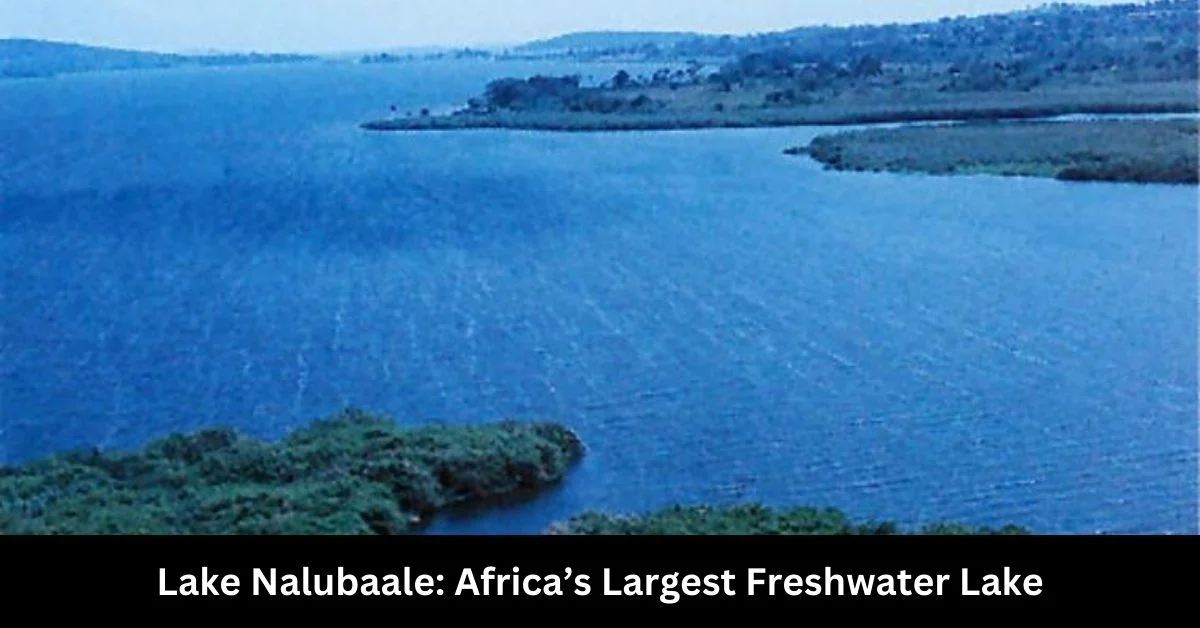Introduction
Lake Nalubaale, widely known as Lake Victoria, stands as Africa’s largest freshwater lake and the world’s second-largest by surface area, spreading across 68,800 square kilometres. Its importance goes far beyond its size, encompassing ecological richness, historical significance, and a deep cultural heritage rooted in East African societies. This article explores every dimension of Lake Nalubaale, from its role in sustaining biodiversity to its cultural importance among local communities, economic contributions, and the ongoing environmental challenges it faces.
Lake Nalubaale is a lifeline for millions, yet it is equally at risk from human impact and climate change. This guide aims to provide an informative, accurate, and comprehensive look at what makes Lake Nalubaale a unique natural wonder in Africa and the challenges we must address to preserve it for generations to come.
Geographical Significance of Lake Nalubaale
Lake Nalubaale spans the borders of three East African nations: Uganda, Tanzania, and Kenya, making it a shared resource with international significance. At an elevation of approximately 1,134 metres above sea level, Lake Nalubaale flows into the Nile River, a critical water source that stretches far beyond Africa.
The lake has several notable islands, such as the Ssese Islands in Uganda, which attract tourists and offer habitat for numerous species. Its vast surface area of 68,800 square kilometres makes it crucial for local climate and water cycles, regulating temperatures and influencing rainfall patterns across the region. Its role as a primary source of the White Nile makes it vital for agriculture, electricity generation, and daily sustenance.
Cultural Heritage and Historical Background of Lake Nalubaale

For centuries, Lake Nalubaale has held profound significance for indigenous communities, particularly among the Baganda people of Uganda. Originally named “Nalubaale” to honor its role as a sacred site, the lake’s waters and shores are woven into local folklore, spiritual practices, and traditional ceremonies. Its current name, Lake Victoria, was given in 1858 by British explorer John Hanning Speke in honour of Queen Victoria—a renaming that remains controversial as it does not reflect the local cultural roots.
Myths and legends around Lake Nalubaale include stories of water spirits believed to dwell in the lake. Rituals are still performed along its shores, where locals gather to seek blessings, healing, and protection. In Baganda tradition, Nalubaale is seen as a giver of life, sustenance, and prosperity.
Biodiversity and Unique Ecosystems in Lake Nalubaale
Lake Nalubaale’s biodiversity is exceptionally rich, housing over 500 fish species, including tilapia, Nile perch, and endemic cichlids. The introduction of Nile perch in the 1950s to boost fisheries dramatically altered the lake’s ecosystem. While economically beneficial, the predatory Nile perch has led to a decline in native species, particularly the smaller cichlids that once flourished.
Bird species, such as kingfishers, cormorants, and African fish eagles, also depend on the lake’s waters and shores for feeding and nesting. The lake’s wetlands and marshlands are home to unique plants that help filter water, providing an essential ecological service.
However, the lake’s ecosystem faces significant threats from invasive species like water hyacinth, which covers the water’s surface, blocking sunlight, and depleting oxygen levels, which endangers fish and plant life.
Also Read: Ai Art Horror iv Needles: Why It Scares Us
Economic Impact of Lake Nalubaale on Local Communities
Lake Nalubaale is a cornerstone of the economy in East Africa. It supports a thriving fishing industry, providing income and food security for millions in Uganda, Tanzania, and Kenya. The lake’s fish exports, particularly Nile perch, generate millions of dollars annually, with substantial portions shipped to Europe and Asia.
Tourism also benefits significantly from the lake’s natural beauty. Activities such as boating, birdwatching, and cultural tours draw both local and international visitors, contributing to local economies. The Ssese Islands, Mabamba Swamp, and other natural sites along the lake attract eco-tourists seeking unique wildlife and serene landscapes.
Beyond fisheries and tourism, the lake supplies fresh water to major cities and is integral to agriculture in the surrounding regions. Many communities rely on the lake’s waters for irrigation, drinking water, and hydropower generation, highlighting its multifaceted economic importance.
Environmental Threats and Challenges Facing Lake Nalubaale

Lake Nalubaale faces numerous environmental threats that endanger its ecosystems and the livelihood of those who rely on it. Pollution from urban runoff, plastic waste, and industrial discharges has significantly affected water quality, leading to eutrophication and algae blooms that reduce oxygen levels in the lake.
Climate change has exacerbated these challenges, with rising temperatures causing water levels to fluctuate. Seasonal droughts and floods affect the lake’s ecosystems and the communities dependent on it for agriculture and daily water needs.
Additionally, deforestation in surrounding areas contributes to soil erosion, causing sediments to wash into the lake and harm fish breeding grounds. Overfishing also remains a critical issue, threatening fish populations and the livelihoods of local fishers.
Conservation Efforts and Sustainability Initiatives
Efforts to conserve Lake Nalubaale are underway, led by both governmental and non-governmental organisations. Uganda, Kenya, and Tanzania are collaborating on conservation projects to manage fisheries sustainably, control invasive species, and reduce pollution. Programs like the Lake Victoria Environmental Management Project (LVEMP) focus on promoting sustainable fishing practices and educating local communities on environmental preservation.
Eco-tourism initiatives are also being encouraged as a way to generate income while preserving the lake’s natural beauty. Local communities are trained in conservation techniques, and schools educate young people on sustainable water use and pollution control.
Despite these efforts, much work remains. Stronger enforcement of environmental laws and policies is necessary to ensure sustainable management. Local stakeholders advocate for increased funding, improved waste management infrastructure, and international cooperation to protect this shared resource.
Also Read: NFL Reddit Streams: Legal Alternatives & Best Options for 2024
The Future of Lake Nalubaale: Preservation and Sustainable Management
The future of Lake Nalubaale relies heavily on the actions of today. With growing awareness about the lake’s environmental and economic importance, there is hope for sustainable management. Governments are urged to adopt stricter pollution control measures and promote eco-friendly development around the lake.
Regional cooperation will play a significant role in the lake’s preservation. Joint conservation efforts by Uganda, Kenya, and Tanzania could ensure a balanced approach to using the lake’s resources without compromising its ecological integrity.
Investing in education, conservation training, and technological advancements will be crucial to safeguarding Lake Nalubaale’s future. Through collaborative efforts, we can work toward a sustainable solution that preserves this vital ecosystem for future generations.
FAQs about Lake Nalubaale
1. What is Lake Nalubaale?
Lake Nalubaale, commonly known as Lake Victoria, is Africa’s largest freshwater lake, located in East Africa and shared by Uganda, Tanzania, and Kenya. It is a vital source of water, biodiversity, and cultural heritage for millions of people in the region.
2. Why is Lake Nalubaale also called Lake Victoria?
The lake was named Lake Victoria in 1858 by British explorer John Hanning Speke in honor of Queen Victoria. However, the original name, Nalubaale, reflects its indigenous cultural significance and is still used by local communities in Uganda.
3. What countries does Lake Nalubaale border?
Lake Nalubaale spans three East African countries: Uganda, Tanzania, and Kenya. It serves as a crucial resource and source of biodiversity for these nations.
4. What kind of wildlife can be found in Lake Nalubaale?
Lake Nalubaale hosts a diverse range of wildlife, including over 500 fish species, various bird species like the African fish eagle, and unique flora. However, some native fish species have declined due to the introduction of Nile perch, an invasive species.
5. How does Lake Nalubaale contribute to the local economy?
The lake supports a major fishing industry, eco-tourism, and agriculture in the region. It also provides water for domestic and industrial use and serves as a source of hydropower, making it an economic powerhouse for East Africa.
Conclusion
Lake Nalubaale is a true African marvel, embodying the natural beauty, cultural heritage, and economic potential of East Africa. However, it faces growing threats from pollution, climate change, and overuse. Through sustainable practices, community involvement, and regional cooperation, it is possible to preserve Lake Nalubaale for generations to come. By valuing this unique resource, we can work together to protect it, ensuring that its waters continue to sustain life and enrich East Africa’s cultural landscape.






